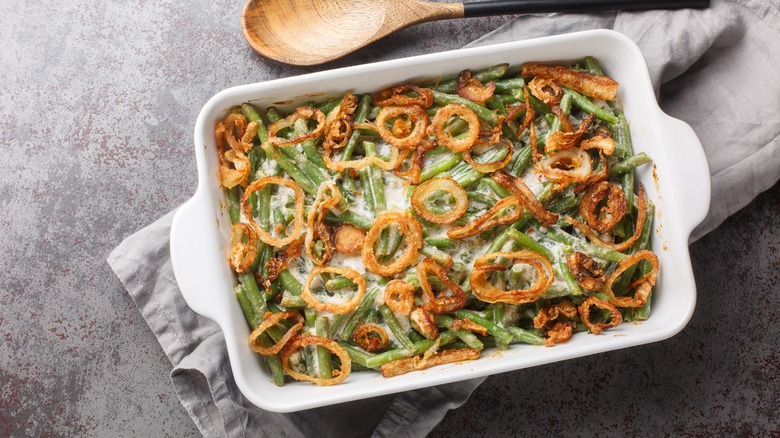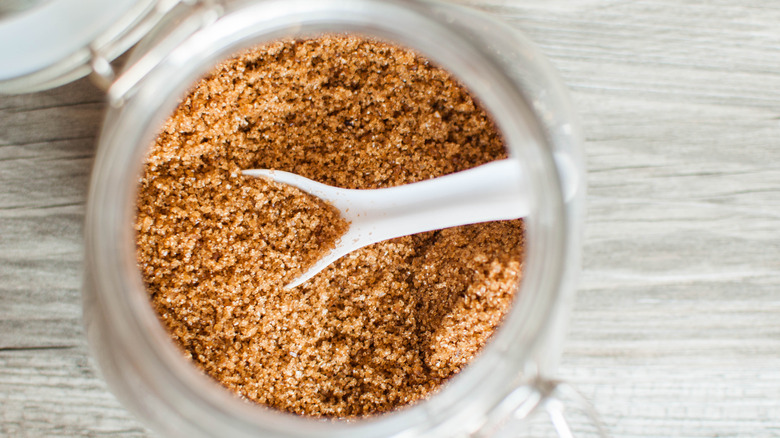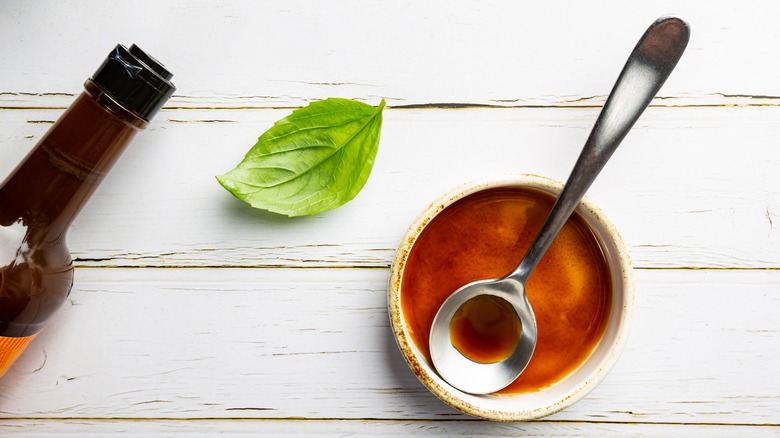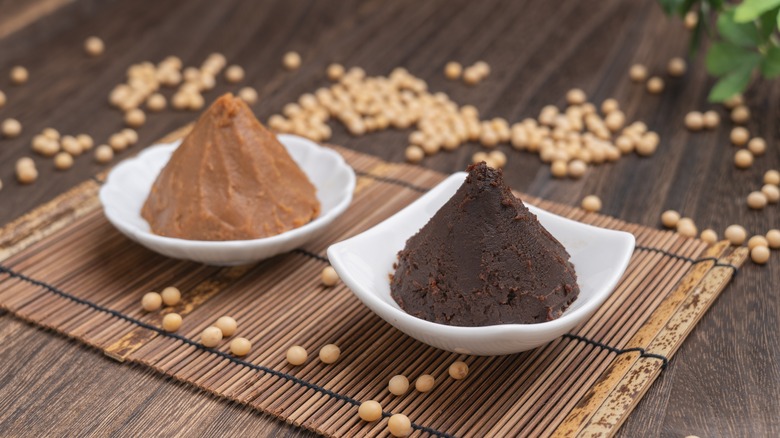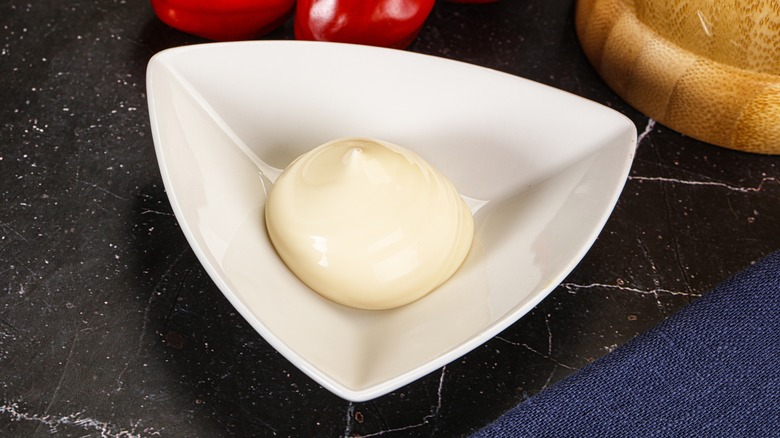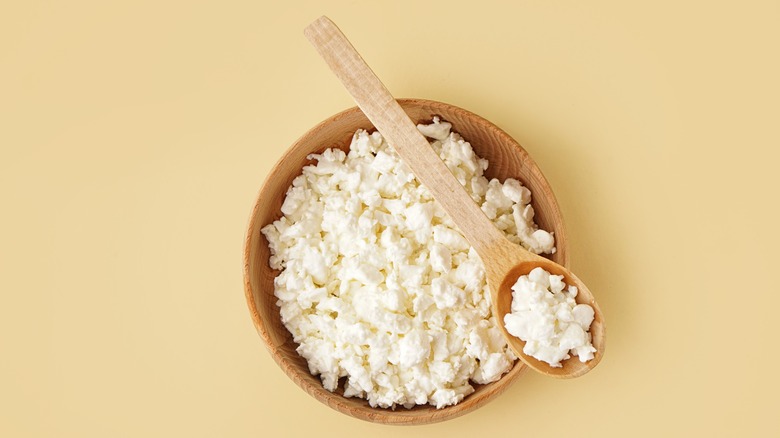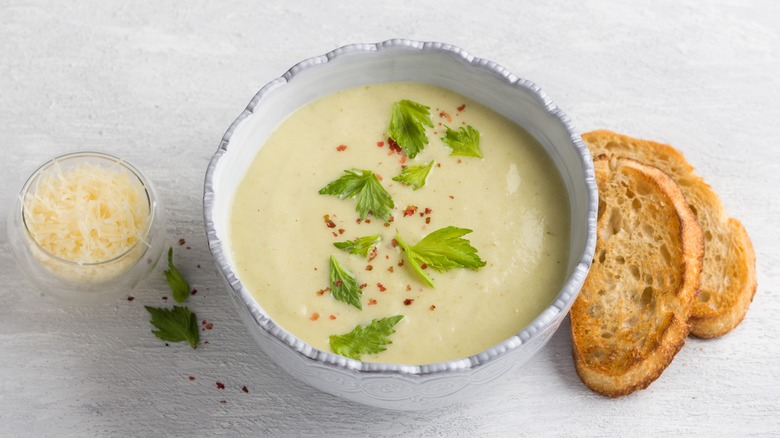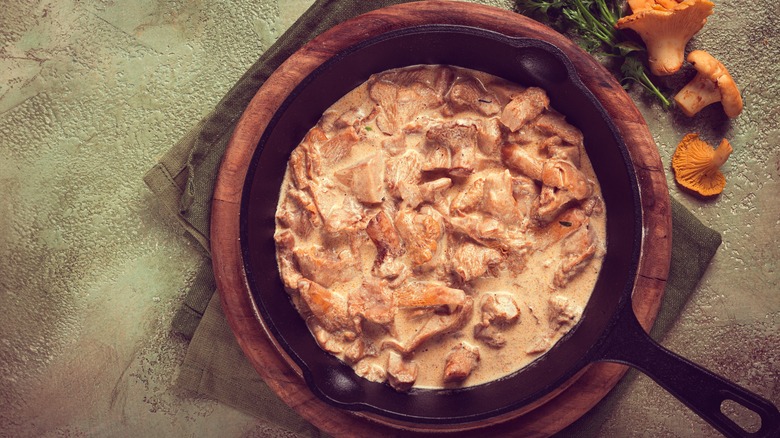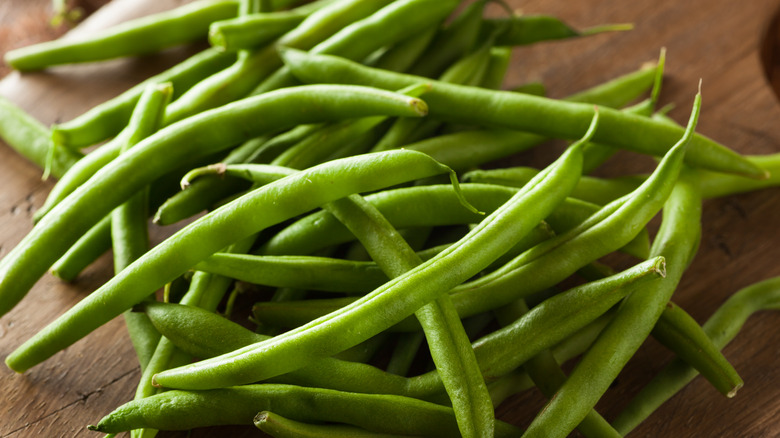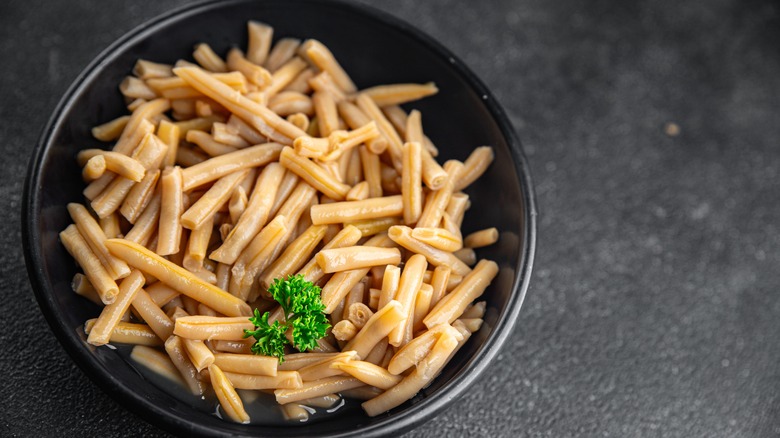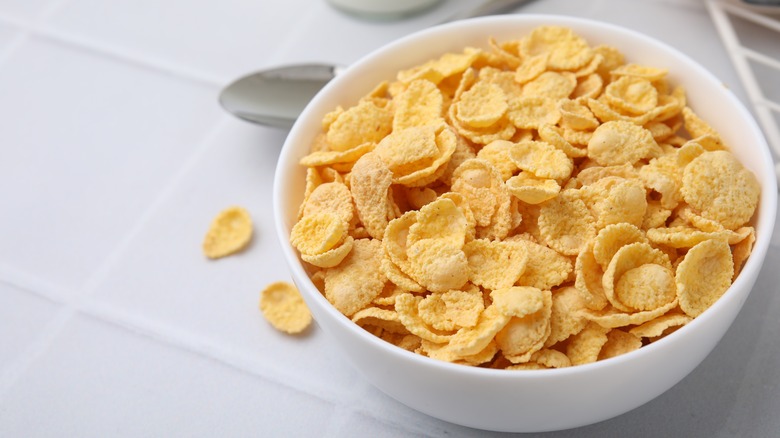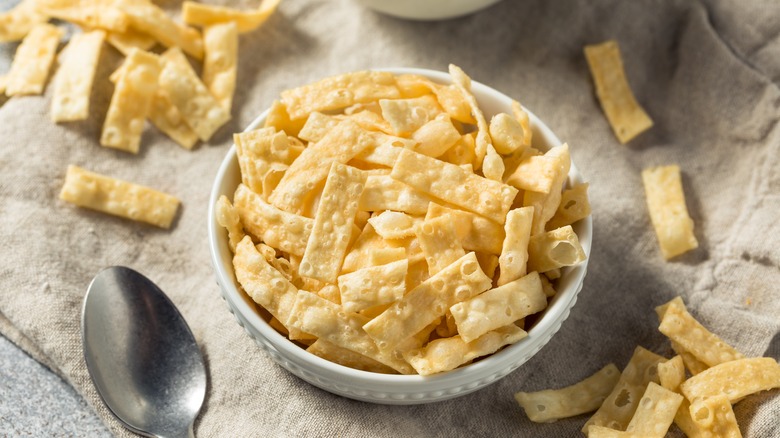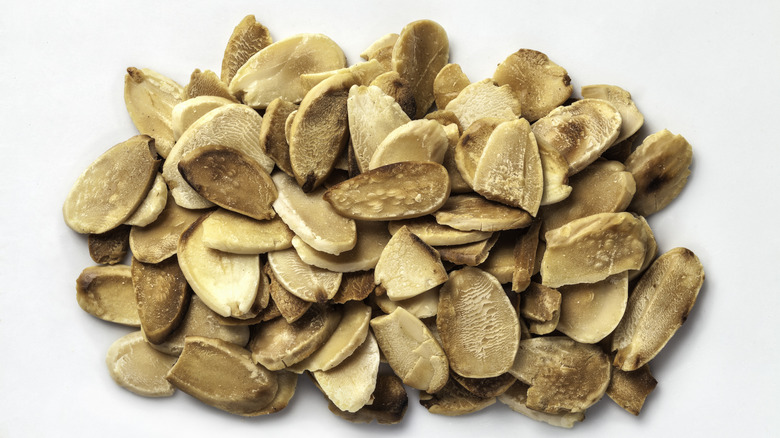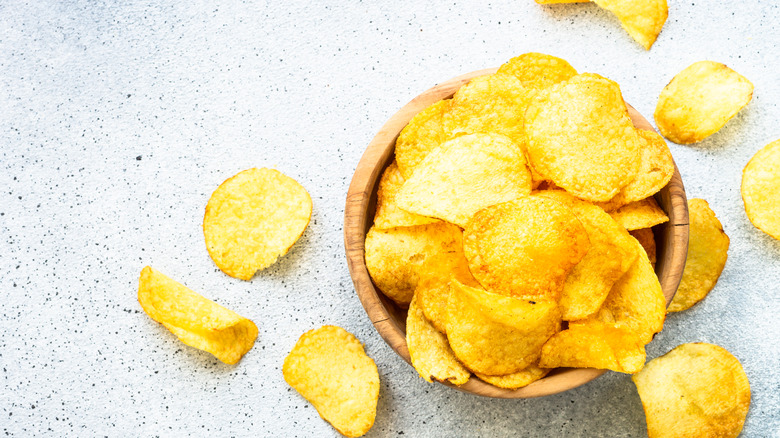13 Ingredient Swaps That Will Make Your Green Bean Casserole So Much Better
When the green bean casserole recipe was introduced by Campbell's Soup Company in 1955, the brand could hardly have imagined how integral this dish would become to holiday celebrations and gatherings in households across the United States. This dish is comfort food at its finest. While the basic recipe remains popular, and there are many tips and tricks for executing it to perfection, sometimes we want to switch things up and make a good thing even better. In our household we call this "chefifying" something, meaning applying the knowledge, experience, and talent of a chef to transforming an average dish into something befitting of a fine dining restaurant.
Indeed, as a professional chef with nearly two decades of experience, I have made my fair share of green bean casseroles to serve dinner guests at our restaurant every Thanksgiving. My versions of this classic were not so out there that the dish lost its inherent identity, but were unique enough that diners would recognize the time and care that went into crafting them. Read on to discover some of the chef-approved ingredient swaps that will make your green bean casserole restaurant-worthy.
1. Swap the soy sauce with brown sugar
In considering ingredient swaps for improving a classic green bean casserole, it is helpful to look at the basic components of the original recipe. These include condensed cream of mushroom soup, canned green beans, milk, soy sauce, and French's fried onions. One ingredient that is easily swapped is the soy sauce, which provides salty, umami-rich flavor to the recipe. When looking for an alternative to soy sauce, brown sugar and green bean casserole may not be the first combo you think of, but it provides more complexity than you might realize.
While brown sugar may not be salty, in my opinion there is plenty of sodium in the soup and French's fried onions without soy sauce. That said, brown sugar contains abundant umami notes, thanks to the molasses within it. It also develops a rich, nutty, caramel-like flavor-profile when it melts into the casserole base as it is heated. These elements help to balance out any residual bitterness from the green beans and amplify the savory qualities of the mushrooms.
In this case, the swap is not a direct one-to-one ratio, as a little bit of soy sauce goes a long way. You will want to adjust the amount of sugar to your liking, but roughly two to three tablespoons per recipe should be ideal to highlight the juxtaposition of sweet and savory elements.
2. Replace soy sauce with Worcestershire sauce
Another ingredient that can be used to swap out the soy sauce in a classic green bean casserole recipe is Worcestershire sauce. This condiment is frequently added to dishes to liven them up and confer both salty and bold, umami flavors, making it comparable to soy sauce in terms of its functions within this recipe. While soy sauce gets its distinct flavor profile from fermented soybeans, Worcestershire sauce obtains its superpowers from tamarind, molasses, and a not-so-secret ingredient that may shock some — anchovies. It may not taste fishy, but these little guys are what provide the quintessential briny and savory notes of this popular condiment.
As I already noted, I typically find that the dish is salty enough with just the mushroom soup and the French's fried onions, so if you plan to use Worcestershire sauce, you may want to consider some adjustments to the basic recipe. First, I recommend obtaining a low-sodium iteration of canned, condensed cream of mushroom soup. I also suggest obtaining low- or no salt added canned green beans. This will help temper the overall salinity within the final dish. That said, it may be helpful to know that despite the piquant flavor of Worcestershire sauce, it is quite a bit lower in sodium than soy sauce, making it a better option for those monitoring their salt intake.
3. Use miso paste in place of soy sauce
A third alternative to soy sauce in a green bean casserole recipe is to substitute it with its fermented soy cousin, miso paste. This popular Japanese condiment has similar properties to soy sauce in the savory and salty departments, though these tend to vary, depending upon the type and amount of used. As a general rule, soy sauce has a slightly more potent flavor, which means it can be used more sparingly, than miso paste. For every 1½ teaspoons of soy sauce, you can use roughly one tablespoon of miso paste.
When shopping for miso, you will find it in different shades, ranging from white to red to yellow. The color of the miso indicates the length of fermentation, which directly correlates to the intensity of the flavor, with white being the mildest and red being the funkiest and most potent. I tend to prefer something middle of the road, like a yellow or mixed miso, which contains elements of both sweet and savory notes that can really amp up the complexity of the flavor of a green bean casserole.
As with other substitutes for soy sauce, you may want to eliminate some of the salinity of the final dish by incorporating low-sodium mushroom soup and low or no salt canned green beans. And, keep in mind that while soy sauce is a liquid, miso is a thick, rich paste, which will influence the final texture of the casserole.
4. Give mayonnaise or Miracle Whip a nod over milk
Another primary ingredient in a classic green bean casserole is milk. The milk helps to thin out the condensed mushroom soup, giving the casserole a creamier consistency. That said, plain milk lacks a bit of flavor, particularly if you use a lower fat content variety. A fabulous alternative is to swap the milk with mayonnaise or Miracle Whip in a green bean casserole.
The choice of which to use is strictly a personal one, and many people have very distinct opinions about which spread reigns supreme. Some purists, myself included, will only use Hellmann's original recipe mayonnaise, while others are less fickle. Still others are staunch supporters of Miracle Whip. While both mayonnaise and Miracle Whip are made from roughly the same ingredients, namely eggs, oil, and vinegar, the latter tends to be sweeter. Ultimately, they will both confer some acidity, velvetiness, and a more complex flavor than milk alone.
Just be sure not to overdo it with the mayonnaise. In this case, a one-to-one swap with milk is not advisable, as too much of this condiment can make the casserole greasy. A couple of tablespoons should be all that are needed for maximum flavor and texture.
5. Swap the milk with cottage cheese
Cottage cheese is another marvelous substitute for milk in a classic green bean casserole. It has a lot of things going for it, including a tangy flavor, rich texture, and a high protein content. The key is using the right kind. In this case, while you may want to opt for a full-fat variety, a low-fat cottage cheese would perform just fine.
I would steer clear of fat-free cottage cheese, as it can be overly watered down and lack some of that tangy flavor and velvety texture you are seeking to add. You should also opt for small versus large curd cottage cheese, as this will yield a creamier, less lumpy dish.
As far as the cottage cheese brand, there are many different ones out there that would work quite well. I would steer clear of those that are on the soupier side, as the excess whey in the cottage cheese can leave your taste buds wanting for more. And, while it may seem tempting to purée the cottage cheese in a food processor or blender before you add it, that is unnecessary. In this case, as the small curds are heated, they will begin to yield, giving the green bean casserole a nice mouthfeel as they burst on your tongue.
6. Go with another soup rather than cream of mushroom
As a mycophile, I always used condensed cream of mushroom soup for my green bean casserole. However, I understand that mushrooms are not everyone's cup of tea. For this reason, or just for the sake of doing something different, you can always opt for a different flavor of condensed creamed soup.
There are many different types and brands out there that would work perfectly well. Among my personal favorites are cream of celery, cream of potato, and cream of chicken. Each of these can be substituted for the mushroom without any adjustments to the recipe. Just keep in mind, that some, like the cream of chicken, will be slightly chunkier, which may make the final casserole a little thicker.
Another alternative is to use a homemade creamed soup. I often make a roasted butternut squash or sweet potato bisque that has a rich, velvety texture and distinctive, autumnal flavor, that would accentuate the festive fall vibes of a classic green bean casserole. If you substitute the condensed soup with these, you may want to eliminate the milk from the recipe, to ensure that the texture of the casserole does not become too loose.
7. Swap the cream of mushrooms soup with a homemade mushroom gravy
No doubt a can of condensed cream of mushroom soup is certainly convenient, but it can be quite high in sodium and lack some of the complexity that you can obtain from a homemade mushroom gravy. For this reason, I typically opt to make my own, using a variety of different mushrooms, including dehydrated ones or mushroom powder, which can really amplify the inherent umami-richness of these fantastic fungi.
When considering the types of mushrooms to use, availability may be a factor, which is why dehydrated mushrooms are such a fantastic resource. Rather than resuscitating them in hot water, consider soaking them in hot stock or white wine before adding them to your gravy. This will infuse them with more flavor, and some of the residual stock can be strained and used to deglaze the pan after sautéing the mushrooms.
One final benefit to making your own mushroom gravy, is that you can be more aggressive with seasonings. I typically use salt, pepper, dried herbs, and freshly grated nutmeg to flavor mushrooms. The nutmeg, in particular, lends a brightness and hint of sweetness that can temper the earthy, grassy notes of the mushrooms.
8. Use fresh green beans instead of canned
Obviously the stars of this casserole are the green beans. Most recipes for this dish call for canned green beans. While these are convenient, affordable, and quite nutritious, they simply cannot compare with fresh green beans when it comes to flavor and texture. Canned green beans also suffer in terms of visual appeal, developing a muted, greyish hue that can give your casserole a rather lackluster appearance. The solution to this is to use fresh green beans.
The best way to prepare fresh green beans for inclusion in this casserole, is to blanch them. Blanching fresh vegetables is ideal for preserving their color, texture, and flavor. Once the beans have been trimmed, dunk them into a pot of gently boiling, salted water. Allow them to cook for a couple of minutes, before retrieving them with a slotted spoon or fine mesh sieve. Immediately transfer them to a bowl of ice water. Doing so will shock them, thereby halting the cooking process and preserving their vibrant hue. I recommend drying the beans thoroughly before combining them with the remaining ingredients in the casserole, to ensure the final dish is not watered down.
9. Try a different type of bean altogether
Whether you use fresh or canned, the options for different types of beans are manyfold. While most are familiar with green varieties, like Blue Lake, Kentucky Wonder, and Kentucky Blue, there are some more colorful beans that can make for equally attractive, and delicious, casseroles, most notably yellow wax beans, Royal Burgundy, and the striated Rattlesnake. These more colorful bean types can be prepared exactly the same way as their verdant cousins, having similarly grassy, earthy, and slightly sweet flavors and al dente textures when blanched.
For something a little more unique, you may want to investigate one of the more exotic varieties of bean, like the long bean, which is ubiquitous in Asian culinary traditions, and the oddly flat-shaped Romano bean, which is an Italian delicacy. The long bean gets its name for its length, but has a tender texture when cooked, so take care not to blanch them for too long, otherwise they can easily get mushy in a casserole. The Romano bean is a stringless variety that is highly versatile. It too is susceptible to overcooking, but its unique shape makes it well-suited to roasting. When using Romanos, skip the blanching process and simply combine them with the remaining casserole recipe ingredients before baking this dish. This time in the oven will help them to develop a unique meaty quality that is highly desirable.
10. Swap the fried onions with corn flakes
When it comes to any casserole, topping it with something slightly crunchy and salty is the ideal final touch. While the classic green bean casserole uses French's Fried Onions for this purpose, there are a number of other options that can be equally as satisfying. As "one of those chefs," I have actually made my own fried onions from scratch, but this is incredibly time consuming and messy without the aid of some commercial equipment, namely a fryer. An alternative that is more accessible, and likely laying around in your pantry, is cereal.
Indeed, crumbled cereal is the casserole topping that you have been needing. The key is knowing which kind to use for this purpose. While a sweet cereal, like Cocoa Puffs, is tasty with milk, it isn't ideal for a savory dish that is loaded with umami-elements. Something with a slightly less saccharine nature will be infinitely more suitable, like corn flakes. Corn flakes have a delightful crunchy texture, and just a dash of natural sweetness, that will not overpower the other elements of this dish.
The easiest way to crumble corn flakes is to give them a spin in a food processor. Just be careful not to turn them into a powder. You want to retain some texture to them so that you get a nice juxtaposition between creamy and crisp in every bite.
11. Scatter wonton strips in place of fried onions
Another superb topping for a green bean casserole, with something of an international flair, are crispy, fried wonton strips. Wonton strips are made by deep frying thinly sliced segments of leftover wonton wrappers. These delicate wrappers, made from flour, water, and eggs, are typically used to assemble various vegetarian and meat filled Asian-style dumplings. When deep fried, they puff up slightly, developing a crisp texture that is almost a cross between a potato chip and Rice Krispies.
Wonton wrappers can be made from scratch or purchased commercially, in plain or flavored varieties, like garlic ginger. Because these strips are somewhat delicate, I like to crush them by hand, rather than in a food processor, which can easily turn them into dust. I transfer the wonton strips to a heavy duty freezer bag and seal it before squishing it with my fingers to pulverize it into bite-sized chunks. These can be sprinkled atop your casserole before baking it in the oven.
12. Substitute French's with chopped, toasted nuts
I am a fan of toasted nuts on virtually anything, but particularly a savory casserole. They not only have a delightful crunchy texture, every type of nut has a distinctive flavor-profile, that can be more or less complementary to the specific ingredients within a casserole. With a green bean casserole, there are inherent earthy, salty, umami-rich flavors that can be amplified by a number of different nuts. Almonds are a classic with green beans, because of their slightly sweet taste, which can tame some of the bitterness of the green beans. Other great options are macadamia nuts and cashews, which have both sweet and savory elements, and somewhat buttery textures, that lend both crunch and creaminess to the final dish.
When using nuts on a casserole, it may seem redundant to toast them before they are sprinkled atop the dish and baked, but I assure you nothing could be farther from the truth. The process of toasting nuts helps to amplify their aroma and flavor, and will firm them up, making chopping them easier. You may need to keep an eye on the nut topping as the casserole bakes. If you notice that they are browning more than you would like, place a sheet of aluminum foil over the casserole to finish cooking it, and prevent the nuts from burning.
13. Replace fried onions with crushed potato chips
One last topping, that I would be remiss in forgetting to recommend as a substitution for the classic French Fried Onions on your next green bean casserole, are crushed potato chips. Crumbled potato chips are the secret weapon to elevating even the humblest of casseroles, from a classic tuna noodle to a baked macaroni and cheese.
The beauty of potato chips is that they come in so many different types and flavors. Chips are available in classic, baked, and kettle cooked varieties, with seasonings varying from plain salt to barbecue to Flamin' Hot Dill Pickle Flavored ones. The sky's the limit in terms of the potential combinations you can use to accentuate the flavors and textures of a green bean casserole.
Like the wonton strips, potato chips can be somewhat delicate, making a food processor potentially a poor choice for crumbling them to the correct texture. I usually transfer the chips to a heavy duty freezer bag and crumble them by hand, before adding them to the top of my green bean casserole and popping it in the oven. The result is a salty, crispy, creamy delight that is sure to titillate your taste buds.
